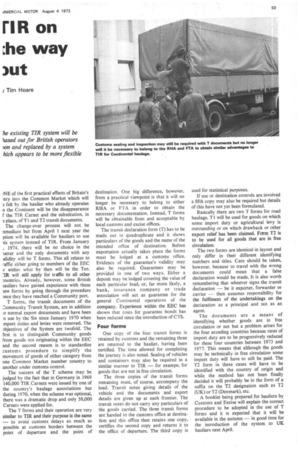FIR on :he way
Page 55

If you've noticed an error in this article please click here to report it so we can fix it.
Tim Hoare
he existing TIR system will be kised out for British operators 'on and replaced by a system hich appears to be more flexible
■ NE of the first practical effects of Britain's itry into the Common Market which will e, felt by the haulier who already operates n the Continent will be the disappearance f the TIR Carnet and the substitution, in s place, of Ti and T2 transit documents.
The change-over process will not be nmediate but from April 1 next year the ption will be available for hauliers to use is system instead of TIR. From January , 1974, there will be no choice in the latter and the only documents with any alidity will be T forms. This all relates to
raffle either going to members of the EEC 4' within what by then will be the Ten.
IR will still apply for traffic to all other ountries. Already, however, some British millers have gained experience with these iew forms by going through the procedure ince they have reached a Community port.
T forms, the transit documents of the community Transit System, are in addition .o normal export documents and have been n use by the Six since January 1970 when mport duties and levies were removed. The 3bjectives of the System are twofold. The irk is to distinguish Community goods from goods not originating within the EEC and the second reason is to standardize customs procedure to simplify the movement of goods of either category from one Common Market member country to another under customs control.
The success of the T scheme may be judged by the fact that in Germany in 1969 140,000 TIR Carnets were issued by one of the country's haulage associations but during 1970, when the scheme was optional, there was a dramatic drop and only 58,000 Carnets were applied for.
The T forms and their operation are very similar to TIR and their purpose is the same — to avoid customs delays as much as possible at customs borders between the point of departure and the point of destination. One big difference, however, from a practical viewpoint is that it will no longer be necessary to belong to either RHA or FTA in order to obtain the necessary documentation. Instead, T forms will be obtainable from and acceptable by local customs and excise offices.
The transit declaration form (T) has to be made out in quadruplicate and it shows particulars of the goods and the name of the intended office of destination. Before exportation actually takes place the forms must be lodged at a customs office. Evidence of the guarantee's validity may also be required. Guarantees may be provided in one of two ways. Either a deposit may be lodged covering the value of each particular load, or, far more likely, a bank, insurance company or trade association will act as guarantee for the general Continental operations of the company. Experience within the EEC has shown that costs for guarantee bonds has been reduced since the introduction of CTS.
Four forms One copy of the four transit forms is retained by customs and the remaining three are returned to the haulier, having been certified. The time allowed for completing the journey is also noted. Sealing of vehicles' and containers may also be required in a similar manner to TIR — for exampe, for goods that are not in free circulation.
The three copies of the transit forms remaining must, of course, accompany the load. Transit notes giving details of the vehicle and the documents and export details are given up at each frontier. The transit notes do not carry any particulars of the goods carried. The three transit forms are handed to the customs office at destination and this office then retains one copy, certifies the second copy and returns it to the office of departure. The third copy is If use or destination controls are involved a fifth copy may also be required but details of this have not yet been formulated.
Basically there are two T forms for road haulage. Ti will be used for goods on which some import duty or agricultural levy is outstanding or on which drawback or other export relief has been claimed. Form T2 is to be used for all goods that are in free circulation.
The two forms are identical in layout and only differ in their different identifying numbers and titles. Care should be taken, however, because to travel with the wrong documents could mean that a false declaration would be made. It is also worth remembering that whoever signs the transit declaration — be it exporter, forwarder or carrier — then assumes responsibility for the fulfilment of the undertakings on the declaration as a principal and not as an agent.
The documents are a means of identifying whether goods are in free circulation or not but a problem arises for the four acceding countries because rates of import duty are to be progressively reduced for these four countries between 1973 and 1977. This means that although the goods may be technically in free circulation some import duty will have to still be paid. The T2 form in these cases will have to be identified with the country of origin and while the method has not been finally decided it will probably be in the form of a suffix on the T2 designation such as T2 (UK) or T2 (Denmark), etc.
A booklet being prepared for hauliers by Customs and Excise will explain the correct procedure to be adopted in the use of T forms and it is expected that it will be available in the autumn — in good time for the introduction of the system to UK hauliers next April.








































































































